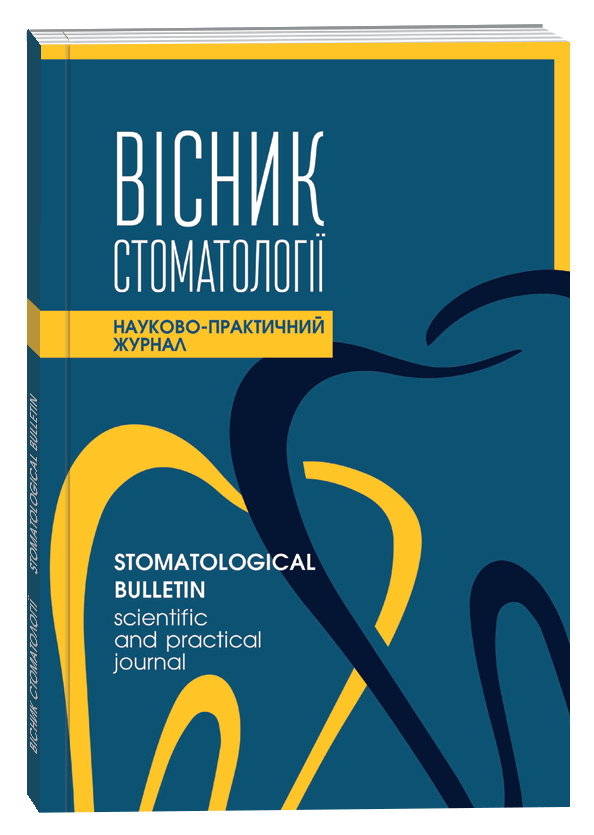X-RAY DIAGNOSIS OF JAW CYSTS IN CHILDREN
DOI:
https://doi.org/10.35220/2078-8916-2023-48-2.15Keywords:
radioloic diagnostic methods, jaw cysts, OPTH, CTAbstract
Radiography is the main method of diagnosing jaw cysts in children. This method allows you to assess the condition of bone tissue, the presence of a cystic cavity – its localization, size, content, relationships with anatomical structures, the condition of teeth, identify the causal tooth in odontogenic cysts, establish a preliminary diagnosis and determine further treatment tactics. To date, the most informative method for diagnosing jaw cysts is computed tomography of bones (CT). It gives a complete picture of the Cystic cavity, its position relative to anatomical structures, the state of bone tissue and causal teeth, and the position of the follicles of permanent teeth in three planes. The purpose of study. To identify radiological features of jaw bones in children and to identify the most informative methods of diagnosis. Research methods. A retrospective analysis of additional rengenological methods of study of 286 medical cases of patients with jaw cysts aged 4 to 17 years. Analysis of disease histories was performed according to the developed examination map. Statistical data processing is performed using the IBM SPSS statistical 23 program. Results. When evaluating X-ray diagnostic methods, attention was paid to the causal teeth and their condition, adjacent teeth and tooth folucules that are wrapped in cystic cavities. The following indicators were found: the roots of causal teeth were resorbed in 82% (n=237) cases, not resorbed in 2% (n=6), adjacent teeth were filled in 53% (N=153) cases, and in 47% (N=133) were intact; the position of the rudiment of permanent teeth was changed in 83% (n=131), and in 17% (n=27). Scientific novelty. Analyzed additional rengenological methods for diagnosing jaw bones in childhood. Conclusions. The main method of diagnosing jaw cysts is radiological, among which the first place is occupied by OPTH. But the most informative method of diagnosis is CT. It allows you to detail the image, detect the presence of a cyst, the relationship to anatomical structures, assess the bone structure during rehabilitation, give clear prognostic criteria for the conception of a permanent tooth.
References
Arvind Babu Rajendra Santosh (2020) Odontogenic Cysts. Dent Clin North Am, 64(1), 105-119 doi:10.1016/j. cden.2019.08.002.
Weber, M., Ries, J., Büttner-Herold, M., Geppert, C.I., Kesting, M., & Wehrhan, F. (2019). Differences in inflammation and bone resorption between apical granulomas, radicular cysts, and dentigerous cysts. J Endod., 45, 1200–8 doi: 10.1016/j.joen.2019.06.014.
Marilena Vered, & John M Wright (2022) Update from the 5th Edition of the World Health Organization Classification of Head and Neck Tumors: Odontogenic and Maxillofacial Bone Tumours Head Neck Pathol.,16(1), 63-75 doi:10.1007/s12105-021-01404-7.
Rioux-Forker, Dana, Deziel, Allyson C., Williams, Larry S., Muzaffar, & Arshad R. 2019. Odontogenic Cysts and Tumors Annals of Plastic Surgery, 82(4), 469-477 doi:10.1097/SAP.0000000000001738.
Mayte Buchbender, Friedrich W Neukam, Rainer Lutz, & Christian M Schmitt (2018). Treatment of enucleated odontogenic jaw cysts: a systematic review. Oral Surg Oral Med Oral Pathol Oral Radiol., 125(5),399-406 doi: 10.1016/j.oooo.2017.12.010.
Mayte Buchbender, Birte Koch, Marco Rainer Kesting, Ragai Edward Matta, Werner Adler, Anna Seidel, & Christian Martin Schmitt (2020) Retrospective 3D analysis of bone regeneration after cystectomy of odontogenic cysts. J Xray Sci Technol., 28(6), 1141-1155 doi: 10.3233/XST-200690.
Zhe-Yi Jiang, Tian-Jun Lan, Wei-Xin Cai, & Qian Tao (2021) Primary clinical study of radiomics for diagnosing simple bone cyst of the jaw Dentomaxillofac Radiol., 50(7),20200384 10.1259/dmfr.20200384.
Masafumi Oda, Pedro V Staziaki, Muhammad M Qureshi,V Carlota Andreu-Arasa, Baojun Li, Koji Takumi, Margaret N Chapman, Albert Wang, Andrew R Salama, & Osamu Sakai. (2019). Using CT texture analysis to differentiate cystic and cystic-appearing odontogenic lesions. Eur J Radiol., 120, 108654 doi: 10.1016/j.ejrad.2019.108654.
Yilmaz, B., & Yalcin, E. D. (2021). Retrospective evaluation of cone-beam computed tomography findings of odontogenic cysts in children and adolescents. Niger J Clin Pract., 24(1), 93-99 doi: 10.4103/njcp.njcp_46_20.
Başak Keskin Yalçin, Hülya Koçak Berberoğlu, Ayşe Aralaşmak, Banu Gürkan Köseoğlu, Sirmahan Çakarer, Merva Soluk Tekkesin, Eser Çarpar, & Ozlem Kula (2022). Evaluation of CT and MRI Imaging Results of Radicular Cysts, Odontogenic Keratocysts, and Dentigerous Cysts and their Contribution to the Differential Diagnosis Curr Med Imaging, 18(14), 1447-1452 doi: 10.2174/1573405618666220509114859.
Stacey L McKinney, & Sherri M Lukes (2021). Dentigerous cyst in a young child: a case report. Can J Dent Hyg., 55(3), 177-181.









